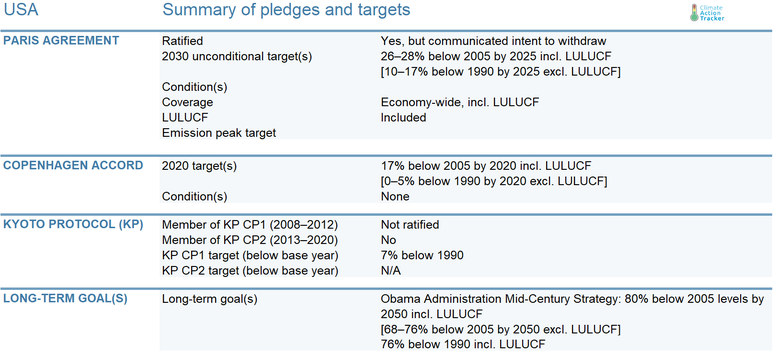Pledges And Targets
Summary table

Paris Agreement targets
On 4 November 2019, the Trump Administration formally notified the United Nations that the US would withdraw from the Paris Agreement (U.S. Department of State, 2019; United Nations, 2019). This was the first possible day that the US could issue such a notification under the Agreement’s rules, and was a move that set the world’s second-largest emitter at odds with the rest of the world. The US exit will take effect exactly one year later, on 4 November 2020, one day after the 2020 US Presidential Elections and would leave the US as one of a only a handful of countries outside the Paris Agreement.
The US NDC set a target of reducing its emissions by 26%–28% below 2005 levels by 2025, including land-use, land-use change and forestry (LULUCF). The CAT estimates that the 26%–28% reduction target in emissions including LULUCF is likely to result in a range of 22%–29% reduction in GHG emissions below 2005 levels excluding LULUCF, depending on whether the sink from LULUCF is at the high or low end of the projections.
2020 pledge
The United States is not a Party to the Kyoto Protocol. While a target of a 7% reduction below 1990 levels from 2008–2012 was originally negotiated and agreed, the US never ratified the Protocol and therefore, the target never came into force.
Under the Copenhagen Accord, the US announced an emissions reduction target of 17% below 2005 levels by 2020 (U.S. Department of State, 2010), which would be around 14%–18% below 2005 levels (excl. LULUCF). The CAT estimates that total emission will decrease by 20%–21% in 2020 below 2005 (excl. LULUCF), as a result of the economic slowdown and other effects of the pandemic, and it will overachieve the 2020 target.
Long-term goal
As part of the Paris Agreement (Article 4), all parties should develop and communicate long-term low greenhouse gas development strategies. On 16 November 2016, the Obama Administration submitted such a strategy entitled “Mid-Century Strategy for Deep Decarbonization” (The White House, 2016b). The strategy sets an emissions reduction target of 80% or more below 2005 levels in 2050, incl. LULUCF. This target is equivalent to 69%–77% below 2005 levels (64%–73% below 1990), excl. LULUCF; the range depending on the magnitude of the LULUCF sinks. The government has now removed the mid-century strategy from all its websites, therefore we do not consider it in our assessment. Once the US withdraws from the Paris Agreement, the Administration will no longer be required to formulate such a strategy.
Further analysis
Latest publications
Stay informed
Subscribe to our newsletter




